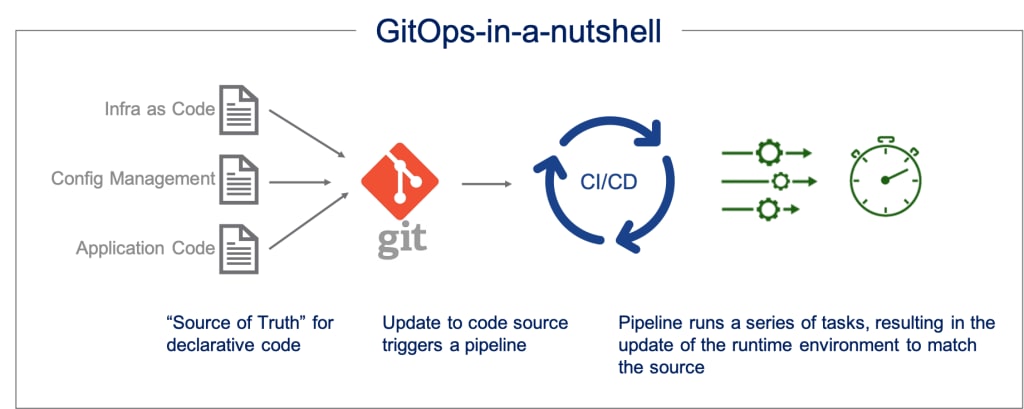what is Gitops
what does it offer and how

GitOps is an operational framework that leverages Git, a popular version control system, to manage and automate the deployment and management of infrastructure and applications. It promotes a declarative approach to infrastructure and application management, making it easier to achieve continuous delivery, scalability, and reliability in modern software development and operations.
Here are some key concepts and components of GitOps:
Git as a Single Source of Truth: In GitOps, the desired state of the infrastructure and applications is described and stored in a Git repository. This Git repository becomes the single source of truth for the entire system. It contains configuration files, deployment manifests, and other relevant resources.
Declarative Infrastructure and Application Management: GitOps relies on declarative specifications to define the desired state of the system. Instead of scripting imperative commands, operators define the desired state in the form of configuration files (e.g., YAML) or infrastructure-as-code templates. The GitOps tooling then ensures that the system converges towards the desired state by continuously monitoring and reconciling any deviations.
Continuous Deployment and Automation: GitOps enables continuous delivery by automating the deployment and management processes. Whenever changes are made to the Git repository, GitOps tools detect the changes and automatically apply them to the target environment. This approach eliminates the need for manual intervention and reduces the risk of human errors.
GitOps Operators and Controllers: GitOps employs operators and controllers that continuously monitor the Git repository and the target environment. These components compare the desired state defined in Git with the current state of the system and perform any necessary actions to ensure convergence. Operators can handle various tasks, such as provisioning infrastructure, deploying applications, scaling resources, and managing configuration changes.
Observability and Auditing: GitOps provides visibility and observability into the entire system. The Git repository serves as an audit log, capturing all changes and revisions made to the infrastructure and application configurations over time. Operators and controllers monitor the system's health and can generate alerts or notifications when deviations occur, making it easier to identify and resolve issues.
GitOps Tooling and Ecosystem: Several tools and platforms support GitOps practices, such as Flux, Argo CD, and Jenkins X. These tools integrate with Git repositories, provide reconciliation and deployment capabilities, and offer additional features like rollbacks, policy enforcement, and integration with CI/CD pipelines. GitOps tooling can be adapted to various cloud environments, container orchestration platforms (e.g., Kubernetes), and infrastructure providers.
Benefits of GitOps:
Version Control: GitOps leverages the benefits of version control, allowing easy tracking and rollbacks to previous configurations.
Consistency and Reproducibility: By defining infrastructure and application configurations in Git, it ensures consistency across environments and enables reproducible deployments.
Collaboration and Code Review: GitOps encourages collaboration, as multiple team members can contribute to infrastructure and application configurations using familiar Git workflows. Code review processes can be applied to infrastructure changes, enhancing code quality and reliability.
Automation and Efficiency: GitOps automates deployment and management processes, reducing manual effort, minimizing human errors, and increasing efficiency.
Auditing and Compliance: The use of Git as a central repository provides an audit trail, making it easier to track changes and comply with regulatory requirements.
GitOps offers a way to streamline and automate infrastructure and application management, fostering a more reliable, scalable, and efficient development and operations workflow. It aligns well with cloud-native and containerized environments, where declarative and automated approaches are crucial for managing complex systems.
Here are some additional aspects of GitOps:
Infrastructure as Code (IaC): GitOps aligns with the Infrastructure as Code (IaC) approach, where infrastructure configurations are treated as code. This means that infrastructure components, such as virtual machines, networks, and storage, are defined using code-like constructs, making it easier to manage, version, and track changes over time. GitOps integrates IaC practices, allowing infrastructure changes to be tracked, reviewed, and deployed through Git.
Continuous Delivery and Rollbacks: GitOps facilitates continuous delivery by enabling frequent and automated deployments. With the desired state defined in Git, the GitOps tooling continuously monitors the repository for changes and automatically deploys those changes to the target environment. In case of issues or regressions, GitOps supports easy rollbacks by reverting to a previous known working state defined in Git.
.
.





Comments
There are no comments for this story
Be the first to respond and start the conversation.